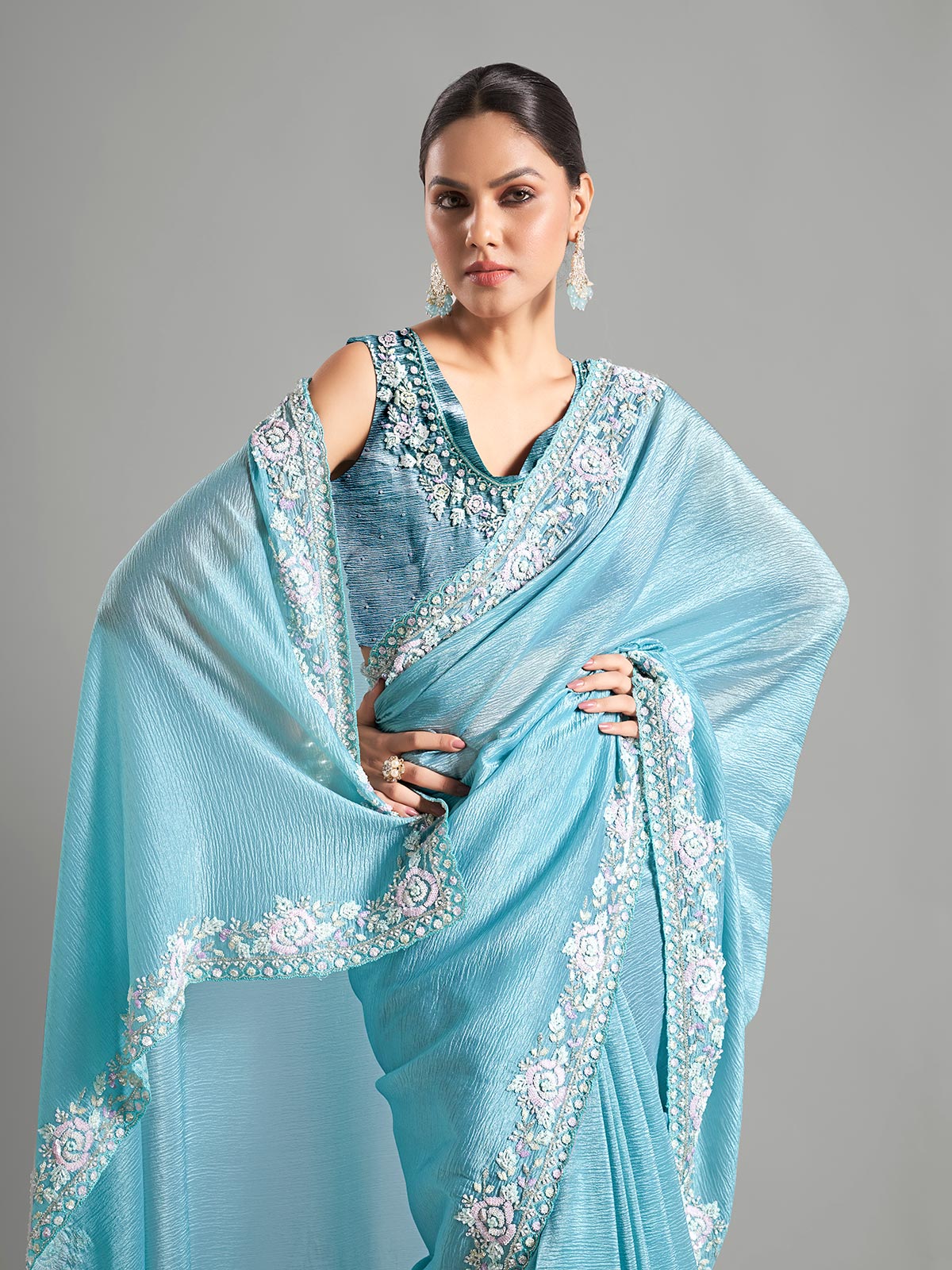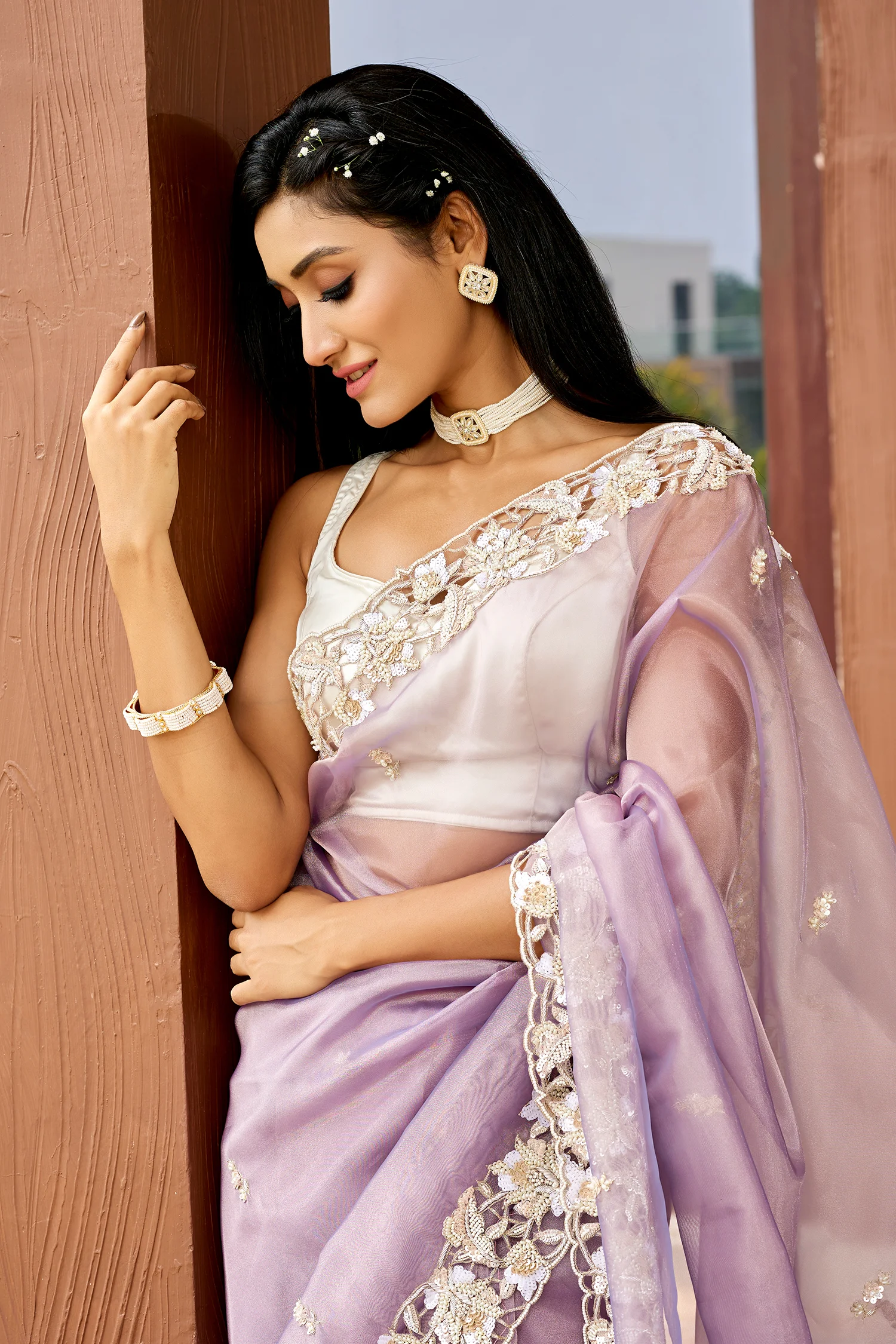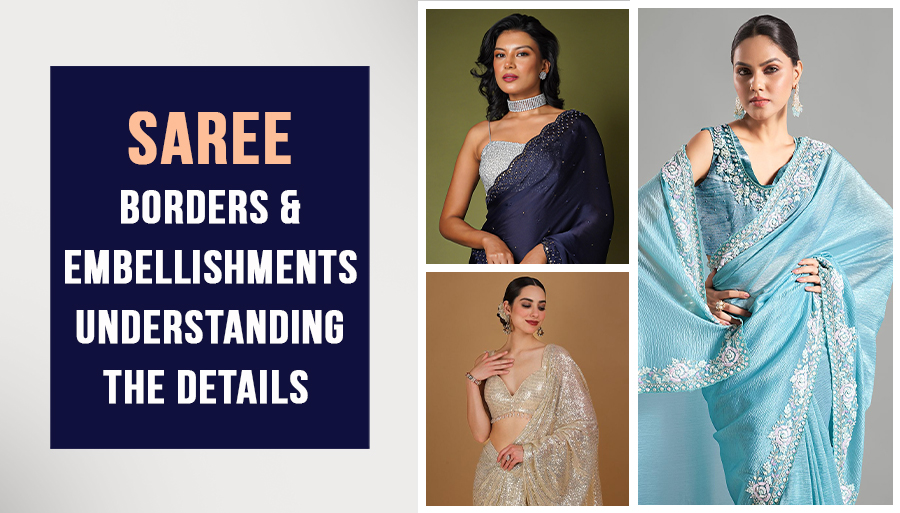Sarees come in various fabrics, colors, patterns, designs, and styles and have always been a staple in women’s wardrobes. It stands as the most iconic outfit for women in South East Asia. Sarees are the subject of fashion experiments in all walks of life and are preferred for their simple yet dignified elegance. The timeless appeal of the saree depends not only on the fabric and draping style but also on the type of borders and embellishments it comes with. They play a crucial role in elevating the visual appeal of sarees besides incorporating tradition, artistry, and craftsmanship.
Let’s explore different types of saree borders and embellishments in this blog.
Understanding the Role of Borders in Sarees
The border of any saree can make or break the overall look. It is a crucial design element that works like a framing around the fabric. It not only adds depth and creates the right contrast but can also add elegance with subtle designs. G3+ Fashion offers an extensive collection of wedding and party wear sarees with border designs and embellishments.
Some key practical and aesthetic purposes borders in a saree serve include the following.
- The border enhances the aesthetic appeal of a saree. Saree borders add to the visual appeal through intricate design patterns. Using contrasting colors for borders is also a common practice.
- The border also helps with structured draping. A neat and well-designed border allows for making neat pleats and pallu, ensuring a smooth, structured saree drape.
- Finally, the border in a saree also celebrates the regional tradition. Just by the borders, many saree varieties are clearly distinguished. For example, the wide and religious-themed borders of Kanjivaram sarees or the Mughal-inspired motifs of borders in Banarasi sarees are well known.
Types of Saree Borders
Saree borders, like other design attributes, widely vary in style and design. Some border types are common in most sarees, while others are common in designer varieties.
Woven Borders
Saree borders with intricately woven design patterns are common to many sarees. From traditional temple-inspired triangular patterns in the borders of Kanjeevaram sarees to the paisley motifs in the borders of Banarasi and Pashmina sarees to the contemporary-styled geometric patterns in modern saree borders, we have quite a variety of woven borders.

Embroidered Borders
In Saree borders, embroidery work is also very common. Zari embroidery is particularly widely used in premium traditional sarees. Metallic golden or silver threads that curve out intricate patterns are called zari designs and are widely used in the borders of festive and bridal sarees. Mirrorwork is also very common in designer sarees. This design involves stitching small reflective mirrors and threadwork, creating a sparkling appearance. Detailed threadwork championing design traditions like chikankari or phulkari is widely used in Saree borders.

Printed Borders
These days modern sarees use printed borders and are mostly used in sarees crafted from breathable and lightweight fabrics like cotton, chiffon, and georgette. The printed borders feature a range of motifs such as floral, abstract, or ethnic tribal motifs. This type of border is ideal when you prefer a casual, trendy, and bohemian vibe.

Lace Borders
Lace designs are used worldwide to border both Western fashion outfits and ethnic dresses. Lace borders, with their delicate designer look and simplicity, are preferred for adding a touch of sophistication. Lace borders are more familiar to sarees crafted using net fabric or other lightweight fabrics like chiffon and georgette. Lace borders are ideal for creating a delicate feminine appeal without overdoing the border of your lightweight saree.
Beaded and sequined Borders
Beads and sequins are more common to borders of designer or partywear sarees that require a glamorous and sparkling appearance. Both beads and sequins stitched into the surrounding threadwork add to the glam of a special-occasion saree. These embellishments are often used in designer sarees and are mostly preferred for evening occasions.

Significance of Embellishments in Sarees
We have mostly talked about the borders and now it’s time to spare a few words on the saree embellishments. Embellishments are decorative design elements that can uphold tradition, create a specific cultural aura, or symbolize a motif. These design elements often turn a regular saree from a simple dress to an artistic fashion outfit. No wonder, embellishments are widely used in designer and partywear sarees. Some of the key purposes served by embellishments in sarees include the following.
- It highlights artistry: Handcrafted embellishments that are often regarded as part of heritage traditions are used to showcase artistry and craftsmanship. Embellishments like zardozi and gota patti are great examples of showcasing the traditional skills of artisans.
- Creating a Festive Vibe: Sarees with gorgeous embellishments easily create a celebratory vibe. Sarees with detailed zari work, beads, mirrors, or sequins look sparkling and instantly resonate with a festive charm common in celebrations and weddings.
- They Represent Traditions: Finally, embellishments often uphold a distinct tradition through their choice of materials and design elements. For example, authentic embroidery and mirror work of a regional saree style upholds the fashion tradition of that particular region.
Most Popular Embellishment Techniques Used in Sarees
A wide variety of embezzlement techniques and corresponding design elements are used in sarees. Notably, each type of embellishment technique represents a unique tradition powered by the evolution of style and craftsmanship. Let’s recap the most popular embellishments used in sarees.
Zardozi Embroidery
Zardozi originally represents a royal heritage art form. It uses metallic golden or silver threads, authentic pearls, and stones in its detailed and sumptuous design motifs. Considering its luxurious and premium design attributes, Zardozi is mostly preferred for bridal sarees.

Gota Patti Work
Gota Patti originated in Rajasthan, and this intricate applique design has already entered the world of designer sarees worldwide. This traditional design uses metallic ribbons to craft rich and detailed motifs. Gota Patti appliqué is a perfect fit for designer sarees.

Mirror Work
Embedding small mirrors in the design is common in Gujarati and Rajasthani sarees. Intricate mirror stitching that creates sparkling reflections best suits the dazzling festive sarees.

Stone and Bead Embellishments
Studding stones and beads into threadwork is another popular type of saree embellishment. Because of the dazzling effect these establishments bring to sarees, beads and stone work sarees are more popular for evening occasions. This embellishment is more commonly used in the borders and pallu of sarees.

Chikankari Embroidery
Chikankari embroidery, a Lucknow-based design tradition, is widely used in designer sarees. This embroidery technique mostly uses white thread on lightweight pastel-hued fabrics. It is widely popular for creating subtlety and elegance in casual and semi-formal sarees.

Sequin Embellishment
Sequins are popular embellishments and are widely used to create a sparkling appearance. If you want to dazzle the senses with an ornately designed saree, a modern saree with a sequin-embedded design can be the right choice. This embellishment also works well with partywear sarees with contemporary design motifs.

Modern Trends in Saree Borders and Embellishments
These days, we also see new and innovative borders and embellishments frequently appearing in contemporary-styled sarees. These modern design trends often abolish traditional design norms. Let’s look at some of these trends.
- Fringe borders often add to the playfulness of sarees bringing a minimalist note.
- Floral 3D appliqué is increasingly becoming more common in creating dramatic effects.
- Metallic hues in golden, copper, or silver color often add to sarees’ trending and modern appeal.
- Minimalist borders and subtle embellishments are also increasingly becoming common for contemporary-styled sarees.
Conclusion
Saree borders and embellishments are no longer just decorative attributes. They represent the design tradition and reflect the mood of the occasion. Lastly, the choice among zari details, zardozi, fringe borders, mirror work, embroidery work, and all other options depends upon the fashion statement you wish to make and what looks best on you.


